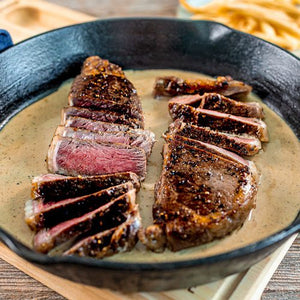FREE SHIPPING ON ORDERS OVER $250!
Call Us for Bulk Orders: (308) 876-2250
BUNDLES
PRESTIGE® GROUND BEEF
PRESTIGE® BUNDLES
SLAB JERKY
BEEF STICKS
SUMMER SAUSAGE
BULK DIY JERKY SEASONINGS
PARTNER PRODUCTS



The only thing that separates these steaks from our standard Prestige NY Strips is the USDA Prime grade. How big of a deal is that…really?? Well, pretty big. USDA Graders are some of the most highly trained eyes in the beef business and they are unwavering in their assessment of beef carcasses. Our cattle grade an exceptionally high percentage of USDA Prime, but it’s still generally less than 10% of our total harvest. Our USDA Prime steaks are very exclusive products and we only offer them on a “when available” basis as we have no way to guarantee that we’ll have an inventory…besides doing everything we can to produce the best cattle possible.
Weight: 0.75 oz
Amazon Link:
Click Here


The 12oz NY Strip is a fantastic steak. The first question many people ask is, “how long should I cook it on each side?”….there is not a consistent answer to that question as there are MANY variables that effect cook time, from the steaks starting temp to the grill surface temp to the ambient temp in which the steak is being cooked. Beyond that, there is a simpler way that is more accurate. The internal temperature of the steak. The way the cooking heat is applied isn’t all that critical, cooking heat can be any variety of methods from a wood fire to a broiler to sous vide; there are MANY great methods to cook a steak. We personally prefer to cook our steaks “rare” and we typically remove larger steaks like the 12oz NY Strip from the heat source when the internal temperature reaches approximately 115-118F. The internal temperature will continue to coast up to somewhere in the 125-130F range. This “coast up” is why adequate “rest time” after cooking is so critical when it comes to cooking the perfect steak. The 12oz NY Strip is a snap to cook due to it’s thickness which doesn’t heat as rapidly as a thinner steak, thus increasing the amount of time to reach finishing temperature.
Order of operations:
• Thaw slowly – submerge in a pan of cool water if you’re in a hurry, NEVER a microwave.
• Season – Your preferred seasoning, to taste. Some folks apply oil to the steak prior to seasoning, we do not believe that is the best approach, nor do we recommend it.
• Cook – Keep track of the internal temp, that’ll tell you when it’s done. Get a good digital thermometer.
• Rest – 5 to 10 minutes is best. Don’t cover the steak when it rests, it will stay warm, covering will cause the “coast up” temp to be higher than desired in most cases.
• Serve – Let your guests carve their own steak, unless they’re little kids or you’re a control freak…cutting a steak is part of a pleasurable eating experience.
The 12oz NY Strip is hard to beat. It comes from the “loin” section of the beef and is a great combination of flavor, texture, tenderness and cook ability. NY Strip steaks are typically boneless, with the exception of its presence on the Porterhouse. The NY Strip will exhibit “marbling” similar to that of the Ribeye, which is what gives the steak it’s flavor and juicy nature. We cut our 12oz NY Strips to approximately 1-1.25” thick. All cattle vary in size so the thickness of the steaks will vary a degree from steak to steak based on the animal from which it came. Lots of folks ask us why our steak thickness varies, and the reason is that we cut our steaks to a specific weight, given the fact that all cattle are slightly different sizes, that means that the variation shows up in the thickness of the steak. If we cut all the steaks to the same thickness, then the weight of the steaks would vary….which would greatly complicate selling them online.
All of our beef is “wet aged” which is a fairly common thing among beef producers. That said, we wet age our beef a minimum of 35 days, which is longer than much of our competition. This makes a difference in flavor and tenderness. The process of wet aging allows enzymes that are naturally present in beef to begin to break down and tenderize the beef. It has more effect on tenderness than it does flavor. Dry Aging, by comparison, is a much different process that relies on the same naturally occurring enzymes to tenderize the beef and dry aging also allows moisture to migrate out of the beef which tends to concentrate the flavor. Dry Aging is a process that is much more like aging artisanal cheese and tends to take on a stronger flavor that not all consumers enjoy. We’ve found “wet aging” for an extended period to be the best case scenario for us.
CRUELTY FREE
ETHICALLY SOURCED
100% NATURAL
MADE LOCALLY
RESPONSIBLE PACKAGING
We use cookies on our website to give you the best shopping experience. By using this site, you agree to its use of cookies.